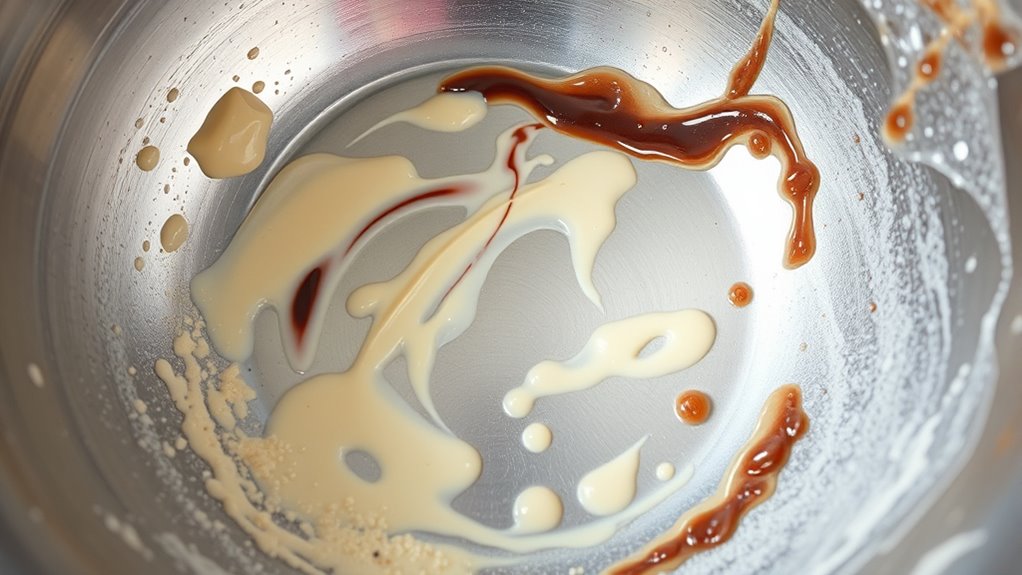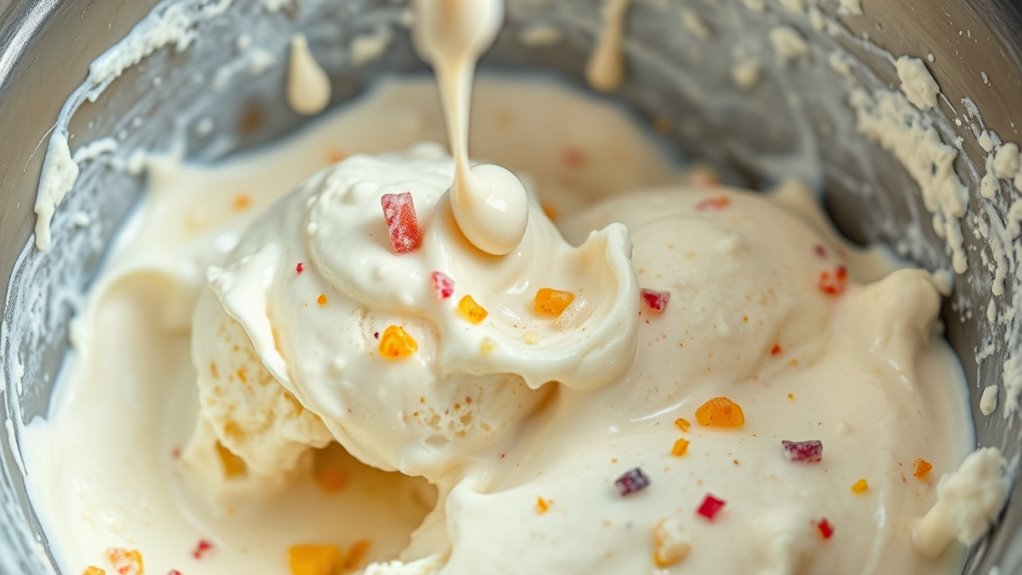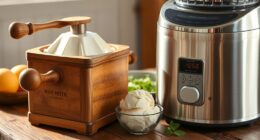If your ice cream maker hasn’t been cleaned recently, it could be harboring mold, bacteria, or residual ice cream that can affect taste and safety. Unplug it first, disassemble removable parts, and wash everything thoroughly with warm, soapy water, paying extra attention to crevices. Rinse well and dry all parts completely before storage or use. Regular cleaning and proper storage help prevent mold growth—keep going to discover more essential tips for keeping your machine spotless.
Key Takeaways
- Disassemble removable parts and wash thoroughly with warm, soapy water to remove residual ice cream and dairy buildup.
- Rinse all components completely to eliminate soap residues that can affect flavor and promote bacteria growth.
- Wipe down the exterior and interior surfaces, drying them completely to prevent mold and moisture accumulation.
- Ensure the freezer bowl is thoroughly dried before storage to prevent mold during idle periods.
- Regularly inspect and maintain your ice cream maker according to manufacturer guidelines to prevent mold and ensure optimal performance.

Ever wondered how to keep your ice cream maker in top shape? Proper cleaning isn’t just about making sure your dessert tastes great; it’s essential for keeping bacteria buildup at bay and preventing mold from developing. If you ignore these steps, you risk compromising your health and shortening the lifespan of your appliance. So, it’s worth taking the time to clean your machine thoroughly after every use.
Start by unplugging your ice cream maker and disassembling all removable parts, like the paddle, bowl, lid, and any attachments. Wash these components with warm, soapy water, using a soft sponge or cloth to scrub away any residual ice cream or dairy. Be meticulous around crevices and hard-to-reach areas where leftover bits can harbor bacteria or mold. Rinsing thoroughly helps remove any soap residue that could interfere with the machine’s operation and affect the flavor of your next batch, especially since residue buildup can be a breeding ground for microbial contamination. Rinse everything thoroughly to wash away soap residue, which can interfere with the machine’s operation and affect the flavor of your next batch.
Unplug, disassemble, wash parts thoroughly, and rinse to prevent bacteria and mold buildup.
Next, focus on the interior of the machine. Wipe down the exterior, paying close attention to the lid and the rim of the bowl, where moisture can collect. Mold prevention hinges on keeping these areas dry and free from residual moisture that can foster mold growth. Use a damp cloth with a mild cleaning solution if needed, then dry all surfaces completely with a clean towel. Avoid using abrasive cleaners or harsh chemicals, as they can damage the plastic or rubber components and introduce unwanted residues. Regular maintenance and proper storage are crucial for preventing mold and ensuring your appliance remains in good condition.
One essential step is to make certain the freezer bowl, if your model has one, is thoroughly dried before storing it. Any lingering moisture can promote mold growth during storage, especially in warm or humid environments. Some manufacturers recommend leaving the bowl slightly ajar or storing it in a dry, ventilated place to prevent mold from developing while idle. Additionally, consulting the manufacturer’s recommended maintenance guidelines can help ensure optimal cleaning and longevity of your appliance. Proper storage and regular inspections are also crucial to prevent mold growth from taking hold. Regular inspections can help catch issues early before they become difficult to eliminate.
Frequently Asked Questions
Can I Use a Dishwasher to Clean My Ice Cream Maker Parts?
You might wonder if you can use a dishwasher to clean your ice cream maker parts. Check the dishwasher safety of each part first—some materials aren’t dishwasher safe and could warp or damage. For cleaning frequency, it’s best to clean parts after each use to prevent bacteria buildup. When in doubt, hand wash with warm, soapy water to keep your ice cream maker in top shape and safe to use.
How Often Should I Sanitize the Ice Cream Maker?
You should disinfect your ice cream maker after every use to maintain hygienic maintenance and prevent bacteria buildup. Establish a regular sanitation schedule, ideally cleaning and sanitizing all parts thoroughly each time you finish making ice cream. This not only keeps your machine safe and clean but also ensures the quality of your frozen treats. Consistent sanitation is key to keeping your ice cream maker in top condition and safe for future use.
Are There Specific Cleaning Products Recommended for Ice Cream Makers?
You should use specialized cleaning solutions designed for ice cream makers to guarantee thorough sanitation. Look for natural disinfectants that are safe and effective, avoiding harsh chemicals that might affect taste or safety. Always follow the manufacturer’s instructions when applying these products. Regular cleaning with these recommended solutions keeps your machine hygienic, prevents mold, and extends its lifespan, ensuring your ice cream stays fresh and delicious every time you make it.
What Is the Best Way to Remove Stubborn Freezer Burn Residues?
Ever struggled with stubborn freezer burn residues? You can effectively remove ice buildup by first softening the residues with warm water and a mild detergent. Then, use a soft brush or cloth to scrub away the ice buildup and residues. Rinse thoroughly and dry completely. This method guarantees proper residue removal, keeps your ice cream maker clean, and prevents future freezer burn issues. Ready to enjoy fresh, tasty ice cream again?
Can I Leave My Ice Cream Maker Out Overnight After Cleaning?
You can leave your ice cream maker out overnight after cleaning, but for ideal storage safety, it’s best to dry all parts thoroughly first. Ensuring proper cleaning frequency helps prevent mold and bacteria growth. If you plan to use it soon, leaving it out is fine, but if you won’t use it for a while, store it in a dry, airtight container. This keeps it fresh and prevents any contamination.
Conclusion
Don’t leave your ice cream maker a dusty relic from the past—clean it now! A quick scrub keeps your treats tasting fresh and your machine running smoothly, just like a well-oiled steampunk gadget. Plus, you’ll avoid any unwanted slime or mold, ensuring every scoop is pure bliss. So, take a moment to tidy up, and enjoy your homemade ice cream without worry. Remember, a clean machine is the secret to sweet success—no need for a time machine to enjoy it!











